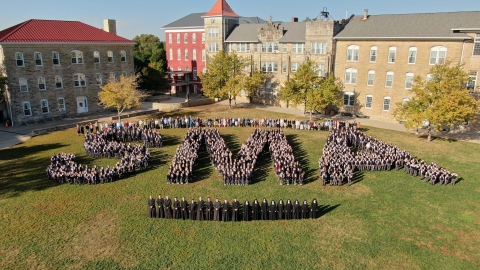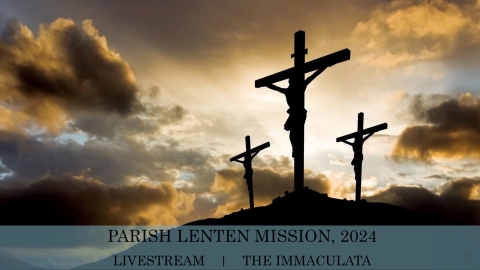New Eucharistic Miracle in Poland

A report on the most recent Eucharistic miracle in Poland with an answer to a common objection.
Recent miracles, which are investigated by scientists and made public by the proper ecclesiastical authority: are they not in the plan of God? And today as in the past, are they not a reminder of His Real Presence, a powerful apologetical argument, and an invitation to increase our faith and devotion?
On Christmas Day, 2013, a consecrated host accidentally fell to the floor during the distribution of Communion in the parish of St. Hyacinth, Legnica, Poland. The priest picked it up and placed the host in a container with water as the rubrics prescribe in such a case. Soon after, red stains appeared on the host.
The then bishop of Legnica, Stefan Cichy, created a commission to investigate it. In February, 2014, a tiny red fragment of the host was separated and placed on a corporal.
The Scientific Process
Samples were taken in order to conduct thorough tests by the Department of Forensic Medicine in Szczecin.
The final medical statement reported that “in the histopathological image, the fragments were found containing the fragmented parts of the cross striated muscle. It is most similar to the heart muscle.” DNA tests also determined the tissue to be of human origin, and found that it bore signs of distress.
The Vatican Investigates
In January 2016, Bishop Kiernikowski presented the matter to the Vatican’s Congregation for the Doctrine of the Faith. On April 10, Bishop Zbigniew Kiernikowski of Legnica made public in a Communiqué that a Eucharistic miracle had happened in 2013. In accordance with the Holy See’s recommendations, he ordered parish priest Andrzej Ziombrze “to prepare a suitable place for the Relic so that the faithful could give it the proper adoration.”
I also ask for providing the visitors with information and conducting the regular teaching that could help the faithful to have the proper attitude to the Eucharistic cult. I also command to form a book to register all received benefits and other miraculous events.”
Bishop Kiernikowski concluded his announcement with these words:
I hope that this will serve to deepen the cult of the Eucharist and will have deep impact on the lives of people facing the Relic. We see the mysterious sign as an extraordinary act of love and goodness of God, who comes to humans in ultimate humiliation.”
In Sokolka, Poland in 2008, a similar miracle took place, and a separate investigation led by Prof. Maria Elizabeth Sobaniec-Łotowka and Prof. Stanislaw Sulkowski, both from the University of Bialystok, concluded that the fragment analyzed was cardiac muscular tissue of a dying man.
Historical Details
Following their conquest of Russia, the Mongols (Tatar) commanded by Batu Khan invaded Poland and Hungary in 1241. As it happened so often in the history, Poland stood up courageously to defend Europe and stop the invaders. At the Battle of Liegnitz, or Legnica, on April 9, 1241, the Mongols defeated a Polish army under Henry II, prince of Lower Silesia.
But this battle put an end to the Mongol invasion for some time. They turned away from Bohemia and Poland and headed south. The Soviets – who often used symbols - had a Red Army battalion in Legnica composed exclusively of soldiers from Central Asia.
The parish where these events happened is dedicated to St. Hyacinth, the first Polish Dominican and companion of St. Dominic. In 1240, during the Siege of Kiev by the Mongols, as the friars were fleeing, Hyacinth went to save the ciborium from the tabernacle in the monastery chapel. He heard the voice of Mary, asking him to take her with him. Hyacinth lifted the large stone statue of Mary and saved both the Blessed Sacrament and Our Lady.
St. Hyacinth's church in Legnica was built in 1904/5 by order of Emperor Guillaume II when Silesia was under the Prussian dominion. It was then a Protestant temple built “in memory of Emperor Frederic III”. In 1945, the Red Army used it as a stable for horses. In 1972, when it was eventually converted to the Catholic Faith, it was the unique case of a Protestant church converted into a Catholic church in recent Polish history.
Answer to a Common Objection
Some may ask the question: how can God allow a miracle to happen in the context of the New Mass?
When we say the New rite is defective, we do not say all the Masses celebrated with this rite are invalid. We say that the rite in itself departs from the unequivocal expression of the Catholic doctrine about the priest, the Real Presence, and the propitiatory character of the sacrifice.
During any valid Mass, the host is consecrated and therefore Our Lord is present under the species of wine and bread, no matter how the reverence of the priest and of the assistants treat Him.
In fact, Church history shows us that Eucharistic miracles - which consist precisely in the appearance of other species - often happen because of doubt or irreverence. At Lanciano, the priest doubted the Real Presence. At Cascia, the priest was irreverent by putting the host in his breviary for a sick call.
Whenever the mass is valid, Our Lord is present. God freely manifests His power by a miracle to rectify the attitude towards the reality of the Eucharist. May these miracles lead to the suppression of Communion in the hand and bring the definitive triumph of the traditional Mass!





